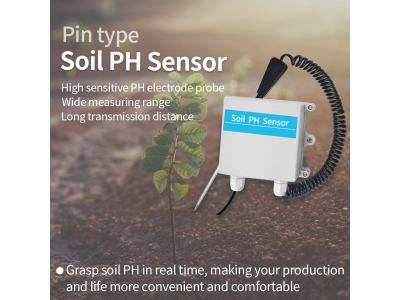Soil sensors have revolutionized the field of agriculture by providing real-time data on various soil parameters. By monitoring factors such as moisture levels, temperature, nutrient content, salinity, and pH, these sensors enable farmers to make informed decisions about irrigation, fertilization, and overall soil management. In this article, we will explore in detail what a soil sensor consists of and how it functions.
Sensor Components:

A soil sensor typically consists of several essential components, each responsible for measuring specific soil parameters. The key components of a soil sensor include:
a. Probe: The probe is the part of the sensor that is inserted into the soil. It contains the necessary sensors or electrodes to measure various soil properties. The probe is usually made of durable materials such as stainless steel or plastic to withstand environmental conditions.
b. Moisture Sensor: The moisture sensor measures the amount of water present in the soil. It can utilize different technologies, such as capacitive, resistive, or time-domain reflectometry (TDR). These sensors provide information on soil moisture content, which is crucial for optimizing irrigation practices.
c. Temperature Sensor: The temperature sensor measures the soil temperature at the depth where it is installed. It helps farmers understand soil temperature variations, which influence plant growth and nutrient availability. Temperature sensors can be based on thermistors, thermocouples, or other temperature-sensing technologies.
d. Nutrient Sensor: Nutrient sensors measure the concentration of specific nutrients in the soil, such as nitrogen, phosphorus, and potassium. They employ various techniques such as ion-selective electrodes or spectroscopy to determine nutrient levels. These sensors support precision nutrient management, enabling farmers to optimize fertilizer application.
e. Salinity Sensor: Salinity sensors measure the salt concentration in the soil. They are particularly useful in areas where high salinity can affect plant growth. Salinity sensors can utilize electrical conductivity or other salinity-sensing technologies to provide accurate measurements.
f. pH Sensor: pH sensors determine the acidity or alkalinity of the soil. They measure the concentration of hydrogen ions in the soil solution. pH sensors are crucial for maintaining optimal pH levels, as different crops have specific pH requirements. These sensors often use glass electrodes or ion-selective field-effect transistors (ISFETs) for pH measurement.
Sensor Deployment and Data Collection:
To ensure accurate and reliable measurements, soil sensors need to be properly deployed and calibrated. Here are the key steps involved in deploying soil sensors and collecting data:
a. Sensor Placement: Soil sensors should be strategically placed at various depths and locations within the field to capture soil variability. For instance, moisture sensors can be installed at different depths to monitor water distribution throughout the root zone. The sensors should be inserted vertically into the soil to minimize disturbances.
b. Calibration: Before deployment, soil sensors must be calibrated to account for soil type and crop-specific factors. Calibration ensures accurate readings and reliable data interpretation. Calibration may involve comparing sensor readings with laboratory analysis or using reference sensors.
c. Data Logging: Soil sensors are often connected to data loggers or wireless systems that record and store the sensor readings. Data loggers can be programmed to collect data at regular intervals. Wireless systems transmit the data in real-time, enabling immediate access to soil information.






